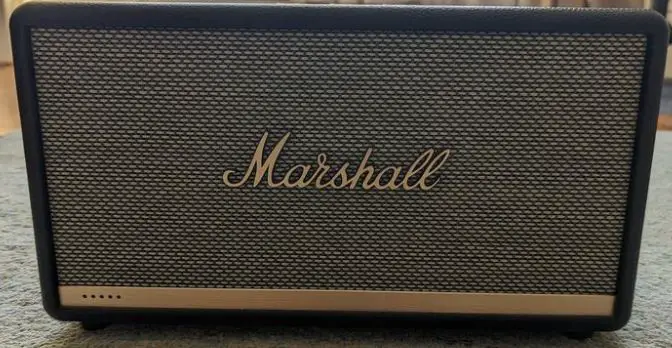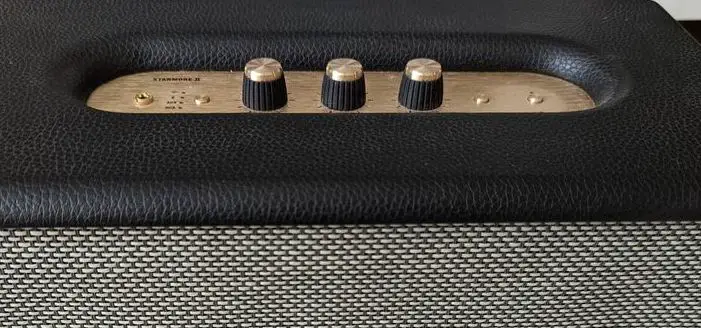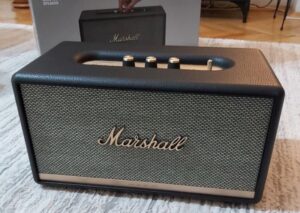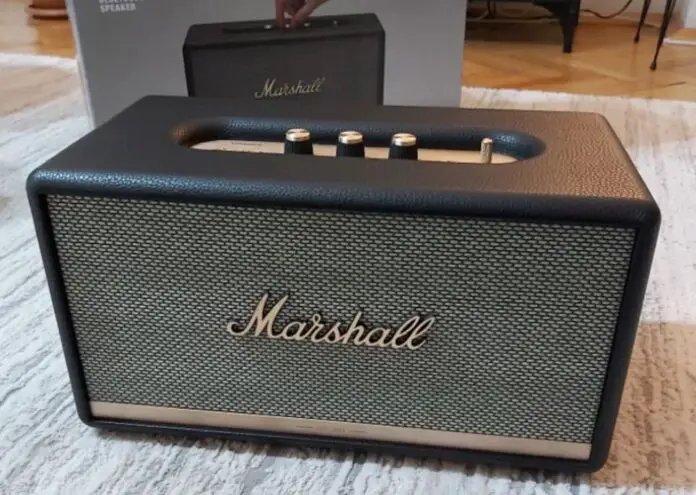The “smart” speaker Marshall Acton II Voice has many high quality features and a nice retro design as the brand’s known identity for its speakers. The firm now sells a variation of certain models, in particular the Acton II Voice. We separated the review of the speaker in different categories to give you a better understanding with ratings.
Table of Contents
Marshall Acton II Voice: Pros and Cons
Pros
- Frequency response span and balance
- Punchy, well-defined bass.
- Very neat construction.
- Simple and pleasant to use.
Cons
- Precision that could have been better in the mids/trebles.
- Very narrow stereo / Pronounced directivity.
- Bluetooth latency a little too high.
Design
With this Acton II Voice, Marshall shows that it still remains attached to his visual identity, which is largely the cause of his popularity.
The manufacturer has nevertheless refined and improved its recipe over the years and the result is there: the manufacturing is very serious and the finishes are particularly neat. We still find the parallelepipedic format and the speaker/amp style look, with very slightly rounded edges.

The speaker is made of several materials: imitation leather like “tolex” on a large part of the speaker, a large grille in rigid mesh fabric, a few touches of brushed aluminum (front plate, top and on the buttons / potentiometers) as well as a rubbery coating surrounding the potentiometers.
The only traces of assembly are the screws placed behind the enclosure and the junction of the “tolex” below. This is far from being prohibitive since these areas are not directly visible.
Connectivity
The Acton II Voice connects wirelessly via Wi-Fi and via Bluetooth (no version information, compatibility with SBC and AAC codecs, no multipoint connection). Unlike many speakers labeled “smart” and under Google Assistant, this model is fortunate to benefit from an analog input in 3.5mm mini-jack.
We appreciate the effort, even if we are still unsatisfied with the possibilities of connection. Connected functionalities are limited to what the Chromecast multimedia ecosystem offers: multiroom and music streaming services such as Spotify, Deezer, Tidal, Google Play Music, Qobuz or TuneIn, for example. No DLNA therefore, nor compatibility with AirPlay.
Like all so-called “intelligent” speakers, the Acton II Voice must go through the configuration box to benefit from all the connected features. This is done directly via the Google Home application and it must be admitted that it is still as efficient and intuitive; whether on iOS or Android.
Setting up the speaker for the first time is very easy in less than five minutes, even if you’ve never used this kind of product — and much less if you’ve already had the opportunity to configure the Voice Match function and connect your streaming service account.
Google Home app on Android left and middle. Marshall Voice app on Android on the right.

Unfortunately, the Google Home app offers few sound customization options. We therefore expected to be able to do this via another application offered by Marshall for the Acton II Voice and the Stanmore II Voice: Marshall Voice (Android and iOS). We were surprised – and a little disappointed, let’s admit it – to learn that it’s actually only compatible with Alexa versions – and very poorly translated from what little we could see.
The Acton II Voice is very easy to use. The basic controls are present: you can manage the listening volume, music playback, switch between the three sources, navigate between the tracks (two or three presses on the pause/play button), activate/deactivate the two onboard microphones to the voice assistant and individually manage the level of bass and treble.
Although the control is digital, the potentiometers are very pleasant to use. To quibble, we would have appreciated an analog control at least for the listening volume potentiometer, for even more precise management. Many light indications are there to guide the user, in addition to some sound and voice alerts brought by Google Assistant. Even beginners will find it.
Voice recognition
The Marshall Acton II Voice has two microphones placed on its top panel. They offer good speech recognition overall. A low-noise environment is however recommended to be fully understood by the assistant.
Voice recognition is provided in a quiet environment without forcing the voice, regardless of our direction relative to the speaker, as long as we are in the same room (approximately 20 m²).
In a room with very little reverberant acoustics, larger or being in an adjacent room, we must speak loudly and intelligibly to trigger the assistant and optimize the understanding of our request.
In a noisier room (a few guests chatting with music playing in the background), you have to approach within 3 m of the speaker to get our message across without any problems.
When the speaker plays the music at a particularly high level (more than 80%), it is still possible to challenge the assistant to submit a request (the music is cut off if the “Ok Google” is heard), but you have to speak very loudly and be less than 2 m from the enclosure.
Sound
The sound performances of the Acton II Voice are very honorable. The speaker offers a relatively well-balanced and powerful sound reproduction, with a very correct extension, both in the bass and in the treble.
The frequency response of the Acton II Voice is well balanced. We nevertheless feel a slight accentuation in the low frequencies that can be easily and precisely adjusted thanks to the dedicated potentiometer on the speaker.
The extension in the lowest frequencies is here very satisfactory given the size of the enclosure. This attacks the reproduction from around 70 Hz (the small peak around 63 Hz results from a standing wave and distorts the measurement a bit).
It benefits from a relatively solid base and a very correct depth. Given the position of the bass-reflex port, be careful not to place the speaker too close to a wall or, worse, in a corner. The rendering at low frequencies would be directly impacted. The Acton II Voice demonstrates precision in this region. The bass is both punchy and well defined and does not impact the higher frequency areas.
The report is a little less brilliant on the side of the mediums. If the balance is always required, it is less the case of precision. Indeed, the loudspeaker shows some weaknesses when it attacks songs rich in harmonics with a very weak dynamic; it is found in very large quantities in rock or metal, for example.
Distortion is slowly coming to the fore and it is then more difficult to clearly distinguish the different sources, especially when there are electric guitars or saturated vocals in the mix. The most fussy will certainly criticize the Acton II Voice for a feeling of presence that is a bit too withdrawn. That being said, the voices are intelligible and the timbres are generally well respected.
The restitution is nonetheless energetic and you can exploit a large part of the power offered by the speaker before the distortion is too great (volume at 85/90% maximum, depending on the content listened to). Even if you never shake the walls, this power reserve is enough to sound a room of a very correct size (about 20 m²) for an evening.
The highest frequencies are very well represented. The Acton II Voice demonstrates a generous extension in the extreme treble. We would have really liked to make the most of it, unfortunately the detail is not incredible and the stereo scene is very narrow, if not non-existent.
We therefore clearly perceive the subtle effects (room effects, reverberations, echoes, etc.), but they are as if confined within the enclosure. The pronounced directivity of the latter also plays a role in this impression. Sometimes a few sibilants are heard.
Finally, it should be noted that the sound reproduction in the treble varies according to the connection mode: in Bluetooth, the speaker puts more frankly forward the frequencies above 8 kHz. In view of the marked directivity of the speaker, the difference is only really audible when being right in front of the speakers.
Marshall Acton II Voice: CONCLUSION
Even if everything is not perfect, the Acton II Voice scores essential points. This model will satisfy people looking for a high-performance and classy Google Assistant (GA) sedentary speaker.
Although it is one of the few GA speakers to offer a mini-jack input, it remains somewhat limited compared to some competitors without a voice assistant, such as the Addon C5. It’s up to you to choose according to your priorities.
Current Best Price on Amazon: $204.94
Price History on Amazon
| Months | Lowest Price on Amazon |
|---|---|
| Sep 2022 | $225.99 |
| Oct 2022 | $225.99 |
| Nov 2022 | $149.99 |
| Dec 2022 | $179.99 |
| Jan 2023 | $204.99 |
| Feb 2023 | $199.99 |
| Mar 2023 | $209.99 |
Marshall Acton II Voice

Marshall Acton II Voice: Detailed Review and Specs. Complete detailed overview and test of Marshall Acton II Voice Wireless Bluetooth speaker
Product Brand: Marshall
Product Currency: USD
Product Price: 225
Product In-Stock: InStock
8.2
Marshall Acton II Voice: Specs
| Length | 260mm |
| Height | 150mm |
| Dimensions – Depth | 160mm |
| Weight | 3kg |
| IP certification | N / A |
| Number of channels | 2 |
| subwoofer | Nope |
| connectors | mini jack |
| Wireless connection | Bluetooth, Wi-Fi |
| Supported Bluetooth codecs | SBC |
| Apps | N / A |
| Network Features | Yes |
| multi-room | Yes |
| wireless protocols | Chromecast |
| voice assistant | Google Assistant |
| Remote | Nope |

